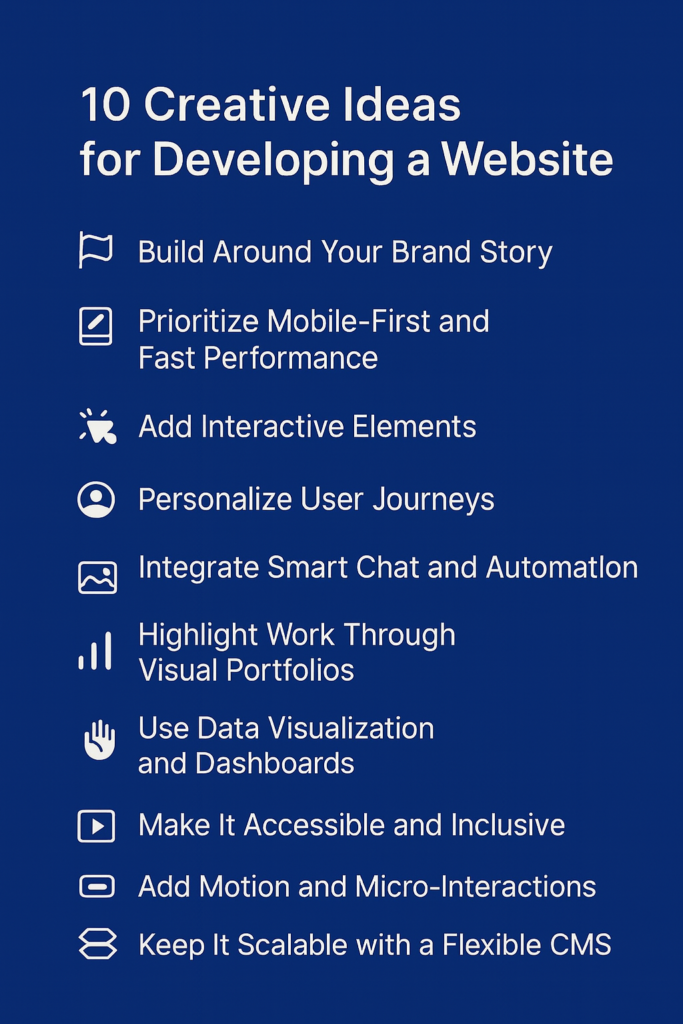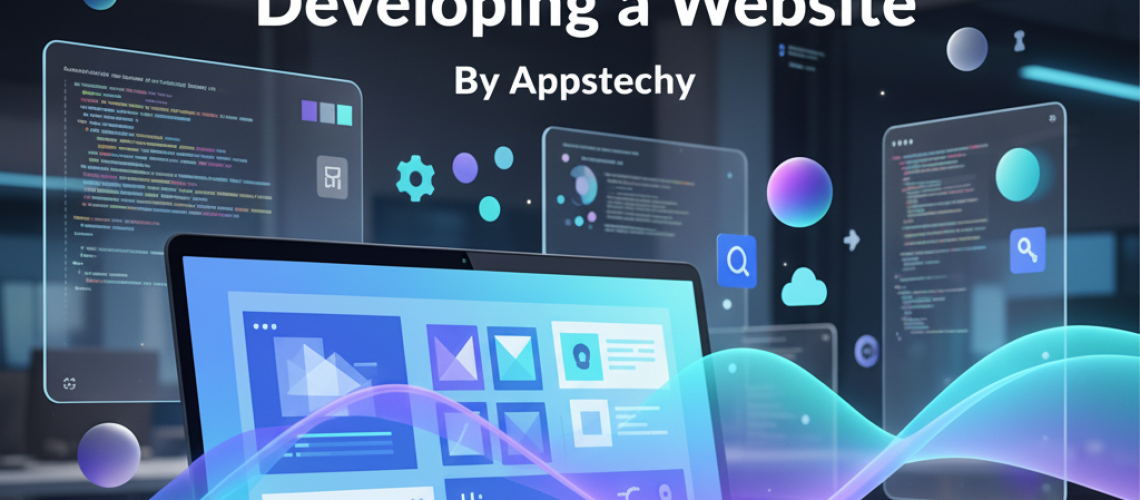In today’s crowded online world, a good website isn’t enough — it needs to captivate, convert, and communicate your brand’s value instantly. Your website is your 24/7 sales engine and often the first impression potential customers will have of your business.
So how do you stand out from cookie-cutter templates and generic designs?
Here are 10 creative ideas for developing a website that blends strategy, design, and innovation to help your business shine online.
1. Build Around Your Brand Story
Every successful website starts with a story. Instead of focusing only on what you sell, showcase why you do it.
Use visuals, timelines, and short videos to bring your journey to life:
- Create a scroll-based story that guides visitors through your company’s growth.
- Add behind-the-scenes content or a founder’s video message.
- Use subtle animations or interactive infographics to make your story feel alive.
Pro tip: A compelling story builds trust and emotional connection — the foundation for long-term customer loyalty.
2. Prioritize Mobile-First and Fast Performance
More than 60% of web traffic comes from mobile devices. If your website isn’t lightning-fast and mobile-friendly, you’re losing visitors — and sales.
Focus on:
- Speed: Compress images, minimize code, and use a CDN.
- Responsive design: Ensure content looks great on any screen.
- Progressive Web Apps (PWAs): Offer an app-like experience right in the browser.
Example: Brands like Starbucks use PWAs to create seamless, app-quality experiences that boost engagement and conversions.
3. Add Interactive Elements
Interactive features can turn a passive visit into an engaging experience. They make your website feel dynamic and help users connect with your brand on a deeper level.
Ideas include:
- Quizzes to match visitors with the right service or product.
- Interactive pricing calculators to help estimate project costs.
- Hover effects and sliders that respond to user actions.
Bonus: Interactive content increases dwell time — great for both engagement and SEO.
4. Personalize User Journeys
Personalization isn’t just for big tech companies. Even small businesses can tailor their websites to user preferences.
Examples:
- Returning visitors see custom greetings or relevant offers.
- Location-based content adapts automatically (“Services in London”).
- AI-powered product or article recommendations.
Result: A personalized experience keeps visitors coming back — and converting.
5. Integrate Smart Chat and Automation
Today’s customers expect instant answers. Adding an intelligent chatbot or automation system can help capture leads and provide support 24/7.
Chatbots can:
- Qualify leads through quick Q&A flows.
- Provide instant FAQs or contact options.
- Route complex queries to human agents when needed.
Pro tip: Combine automation with personalization — e.g., greet returning visitors by name or recall previous interactions.
6. Highlight Work Through Visual Portfolios
If you’re a creative, service-based, or technical business, your portfolio is your proof of excellence. Make it easy to explore and visually appealing.
Try:
- A filterable gallery that sorts projects by industry.
- Before-and-after sliders to show transformations.
- Mini case studies with outcomes and client feedback.
Example: A design agency could present each project as a short narrative — from idea to results — to build credibility.
7. Use Data Visualization and Dashboards
Data can tell powerful stories — when presented well.
Use charts, dashboards, or interactive graphics to:
- Showcase performance results or sustainability metrics.
- Highlight social proof (number of clients, trees planted, or projects delivered).
- Display live data pulled from APIs or CRMs.
Tools like Chart.js, D3.js, or Google Data Studio can help create stunning, dynamic visuals.
8. Make It Accessible and Inclusive
Accessibility isn’t just good practice — it’s essential. A truly inclusive website reaches everyone, including people with disabilities.
Ensure your site meets WCAG standards by:
- Using clear typography and strong color contrast.
- Adding alt text for images and captions for videos.
- Making forms and menus keyboard-friendly.
Bonus: Accessibility boosts SEO and brand reputation while widening your audience reach.
9. Add Motion and Micro-Interactions
Small details make a big impact. Animations, hover effects, and scroll transitions can make your site feel premium and alive.
Examples:
- Animated icons or buttons that react on hover.
- Smooth scrolling transitions between sections.
- Progress indicators for multi-step forms.
Use tools like Framer Motion or GSAP to create smooth, performance-optimized motion effects.
10. Keep It Scalable with a Flexible CMS
Your website should grow as your business evolves. Choose a CMS that gives you flexibility and control.
Popular options:
- WordPress – versatile, plugin-rich, and easy to manage.
- Webflow – ideal for visual design and quick iteration.
- Headless CMS (like Strapi or Sanity) – best for scalability and API integration.
A scalable CMS future-proofs your site, saving you time and money long-term.

Final Thoughts: Creativity Meets Strategy
A creative website isn’t just about looking good — it’s about blending design, performance, and storytelling into one powerful experience.
When your site aligns with your business goals and user needs, it becomes more than an online presence — it becomes your most valuable marketing asset.
How Appstechy Can Turn Your Vision into Reality
At Appstechy, we specialize in crafting custom, high-performing websites that blend creativity with strategy. From UX design and web development to SEO and automation, we help businesses build digital experiences that convert.
Whether you’re launching a new brand or redesigning your website, our team can transform your ideas into a fully functional, visually stunning online platform.
👉 Let’s build something remarkable together.
Contact Appstechy today to discuss your website vision.
Frequently Asked Questions (FAQ)
1. What makes a website “creative”?
A creative website goes beyond templates — it uses storytelling, visuals, interactivity, and personalized experiences to capture attention and reflect your unique brand identity.
2. How much does it cost to develop a creative website?
Costs vary depending on features, design complexity, and integrations. A small business site might range from $2,000–$10,000, while fully custom builds can go higher. Appstechy offers flexible packages and website development services tailored to your goals and budget.
3. How long does it take to develop a custom website?
Typically, 4–8 weeks for a standard site and 10–12 weeks for complex or eCommerce builds. The timeline depends on content readiness, revisions, and technical requirements.
4. What’s the difference between web design and web development?
- Web design focuses on layout, visuals, and user experience (UX).
- Web development brings that design to life through coding, CMS integration, and functionality.
Appstechy’s team handles both seamlessly for a complete, start-to-finish solution.
5. Can you redesign my existing website?
Absolutely. Appstechy can perform a full audit, modernize your design, improve speed and mobile performance, and integrate new features to align with your business goals.
6. Why should I choose Appstechy?
Because we don’t just build websites — we create digital experiences that grow your business. Our expert team combines creativity, strategy, and technology to deliver results-driven web solutions tailored to your brand.




